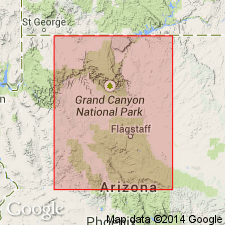
- Usage in publication:
-
- Lava Falls tongue
- Modifications:
-
- Original reference
- Dominant lithology:
-
- Limestone
- Dolomite
- Shale
- AAPG geologic province:
-
- Plateau sedimentary province
Summary:
"It is confusing, from McKee's text and fig. 1 whether the tongue is assigned to the Muav formation or to the Bright Angel shale" (GNC note, n.d.). Lava Falls tongue [of Muav formation of Tonto group] (USGS Bull. 1200); Lava Falls tongue [of Bright Angel shale of Tonto group] (USGS DDS-6).
Pg. 14 (fig. 1), 29, 95. Consists partly of aphanitic limestone and partly of fine-grained dolomite, but nearly everywhere weathers into a resistant cliff with red-brown surface. At type section, divisible into three units; basal ledge-forming dolomitic limestone; middle slope-forming unit of green shale and brown siltstone; and upper cliff-forming carbonate unit. Eastward extension of carbonate deposits from Spencer Canyon member (new) of Muav formation. Thickness at Granite Park 20 feet; farther east at Toroweap 17.5 feet, and at Gateway Canyon 16.5 feet. Older than Parashant tongue (new); younger than Garnet Canyon tongue (new). [On p. 29 age stated to be Early and Middle Cambrian and on p. 184 (part 2) Middle Cambrian. Age is considered Early and(or) Middle Cambrian.]
Type locality: about 1 mi east of Lava Falls at foot of Toroweap Canyon, Grand Canyon, Coconino Co., northwestern AZ.
Source: US geologic names lexicon (USGS Bull. 1200, p. 2119); supplemental information from GNU records (USGS DDS-6; Menlo GNULEX, Denver GNULEX), GNC index card files.
For more information, please contact Nancy Stamm, Geologic Names Committee Secretary.
Asterisk (*) indicates published by U.S. Geological Survey authors.
"No current usage" (†) implies that a name has been abandoned or has fallen into disuse. Former usage and, if known, replacement name given in parentheses ( ).
Slash (/) indicates name conflicts with nomenclatural guidelines (CSN, 1933; ACSN, 1961, 1970; NACSN, 1983, 2005, 2021). May be explained within brackets ([ ]).

